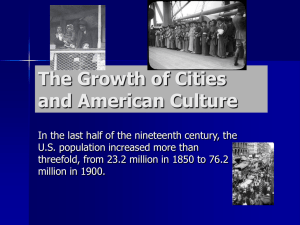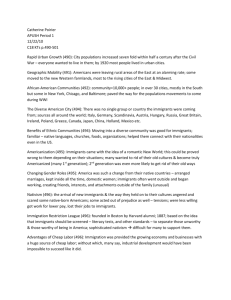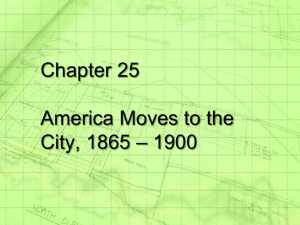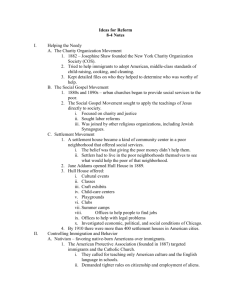Immigration, Urbanization, and Everyday Life 1860-1900
advertisement
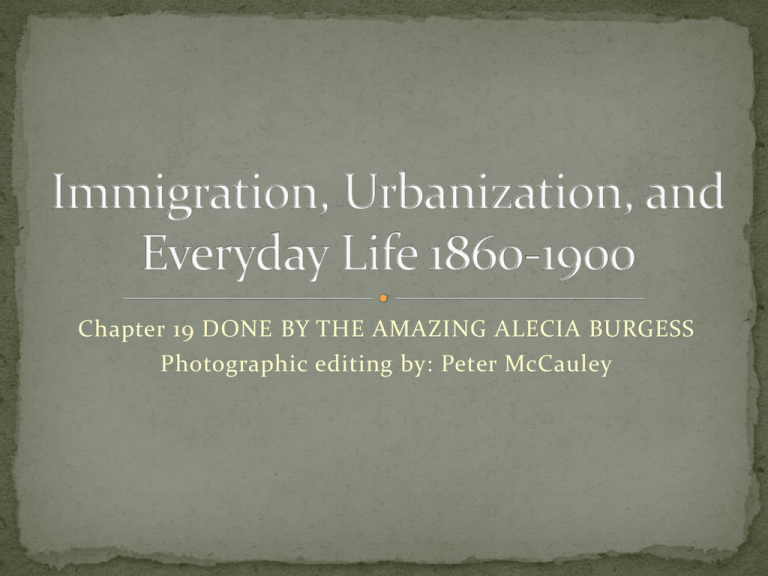
Chapter 19 DONE BY THE AMAZING ALECIA BURGESS Photographic editing by: Peter McCauley Changes most visible in cities Population of cities grew rapidly in both North and South Chicago Population grew by 5x New Orleans 1870-1900 population doubled Massive immigration 1870-1900 11 million immigrants Cities “opportunity” Conflict with natives Concentration of industry Immigrants in cities created jobs Pull factors: Good wages Broad range of jobs Migration so severe towns literally wiped out New England Women’s need reduced on farm Agricultural innovations, reduced subsistence tasks Exodus to cities Northern European 1860s-1880s Flocked to NE coast Germans 3 million English, Scottish, Welsh Irish 1.5 million West Coast Chinese 81,000 Chinese Exclusion Act 1882 1890’s “new” immigrants Italians, Greeks, Slavs, Jews, Armenians Mainly single men Embarked at Hamburg, Germany Difficult journey Deplorable conditions Customs Physical examinations Entry points Castle Garden, ,1855 NY Ellis Island, 1892 NY Angel Island, 1910 CA Adjustment Exchanged currency Arranged lodgings Purchased railroad tickets Chain Migration Chinatown, Little Italy Adjustment Skilled w/ Anglo-American customs British Isles immigrants adaptation easier Irish Large population Dominate Democratic party politics Control Catholic church’s hierarchy in major NE cities New sense of Ethnic distinctiveness Irish-American To assimilate, or not? Chinese, some Irish Made enough money to return home to be successful Nearly 50% went back to Italy Generally clustered within walking distance of manufacturing districts Began with landlords subdividing old buildings Over packed with residents Poor the renters, the worse the slum Ghettos When pressure, law, and prejudice prevent from renting elsewhere Difficulties Children Whooping cough, scarlet fever, high IMR Near Industrial districts Noise, pollution, foul odors 1870s, 1880s Wealthy, city dwellers moved to suburbs Distance from tenements Middle-class Copy rich Live on outskirts “suburban sprawl” Informal segregation Trolley cars allow boundary expansion Lower-class spending Encourage spending of lower-classes “high-quality, low-cost” merchandise advertized New Stores Macy’s New York Wannamaker’s Philly Marshall Fields Chicago Advertised “rock-bottom” prices Price wars End of season sales Big difference between upper/middle class and working class Highlighted in growing urban centers Political Bosses and Machine Politics Early 19th century, swelling urban poor gave rise to new types of politicians Listened and lobbied to improve the poor’s lot Presided over city’s “machine” Unofficial political organization designed to keep a party or faction in office Assisted local ward and precinct captains Enormous influence Tammany Hall Started as fraternal order after revolutionary war Democratic, 1830s-1930s Other machines in Baltimore, Philly, Atlanta, and San Francisco Controlled fire and police departments Rewarded friends Tax breaks for contractors Welfare agent Needed to be viewed as generous Tangled urban services with corrupt politics Boss Tweed 1869-1871 Put city $70 million in debt Satirized by Thomas Nast Convicted of fraud and corruption in 1873 Jacob Riis Believed basic cause of urban distress was immigrants lack of self-discipline and self-control Focused on moral improvements “Americanize” immigrants Targets youth first Hartley, Brace, YMCA, YWCA Religious, moral Offered alternatives to slums New Approaches Salvation Army 1865, England Food, shelter, temp. employment Slum brigades New York Charity Organization Society 1882 Scientific approach Josephine Shaw Lowell Divided NYC into districts Kept files, self-sufficiency Moral and Purity Campaign 1872 NY Society for Suppression of Vice Close gambling, lottery, censor obscene publications Prostitution Big issue Morally wrong, but sense of freedom and source of income for women 1892 Gambling dens, saloons, and brothels targeted Charles Parkhurst City Vigilance League Only lasted 3 years 1870s, 1880s Protestant ministers Radical alternatives Rich deserved part of the blame, had responsibility William S. Rainsford “institutional church movements” Help immigrants Boy’s clubs, rec facilities for poor, industrial training programs J.P. Morgan helped Social Gospel Movement 1870s, Washington Gladden (protestant) True Christianity commits those to fight social injustice anywhere it exists Walter Rauschenbusch Minister in “hell’s kitchen” Christian society would unite all churches, reorganize industrial system, and work for international peace Federal Council of Churches 1908 All religions found need to adapt to stresses and challenges of modern urban living Catholics Lots of immigrants Defended unions Protestants Dwight Moody Moody Bible Institute Chicago 1889 Salvation Army Imported from England 1879 Provided basic necessities for homeless and poor Preached Christian gospel New Approach Relief workers live in slums and ghettos See struggle “first hand” Jane Addams Advocate Hull House –Chicag0 1889 By 1895 50 Settlement houses in nation Usually led by women Sisterhood of reform New hope Victorian Era After Queen Victoria Set of social ideas and morals E.L. Godkin The Nation Minister Believed financial success of middle and upper class linked to their superior talent, classes were linked to their superior talent, intelligence, morality, and self-control Separate spheres Reinforced by: Elegant department stores Elite colleges and universities Manners and Morals Victorian Views Emerged 1830s-1840s Resisted on the assumptions: Human nature malleable, could be improved Social value of work Development of self-discipline, self-control Advance progress of the nation Good manners Value of literature, fine arts Reformers Henry Ward Beecher manners/ protocol Pre-civil war: slavery/alcoholism Carrie Nation hatchet/ saloons Catherine Beecher The American Woman’s Home 1869 1840s Architects, clergyman, and other “professionals” promoted the idea 1880s, 1890s New obligation: foster an artistic environment to nurture family’s cultural improvement Social Sciences and Professions Application of scientific method and theory of evolution New social sciences Behavioral psychology, sociology, anthropology, and political science Professions Law Oliver Wendell Holmes Jr. argues law should evolve with times Clarence Darrow Criminal behavior could be caused by background The African-American Debate W.E.B. Du Bois Advocated full rights for Blacks and equal access to education Booker T. Washington Hard work, racism would disappear Concern that Americans lacked sufficient knowledge Reformers William Torrey Harris # of years in school increased Order and punctuality in classroom Compulsory attendance Tenure system Catholics Opened parochial schools Felt public school was anti-catholic 1900 1880-1900 150 colleges Morrill Land Grant Act 1862 Only 4% of 18-21 enrolled in college Wealthy capitalists endowed schools Requirements More electives Modern languages and sciences 1st generation of scholars who could compete with Europe Medical Schools Revolutionized by Cornell and Harvard Changed lax standards Copied European curriculum Other degrees followed suit: Law programs Wide variety of subjects Architecture Followed Louis Sullivan Chicago 1880s, 1890s Building’s form should follow function Frank Lloyd Wright Prairie houses 1890s “organic” style Chicago Anti-Victorian Daniel H. Burnham Chicago Columbian Exposition 1893 (World’s Fair) Genteel Tradition and its Critics 1870s, 1880s Movement to improve American taste in interior furnishing, textiles, ceramics, wallpaper, and books Goal: create a national artistic culture New guidelines for literature Remove sexual allusions, vulgar slang, etc. Rebels Mark Twain Huckleberry Finn Theodore Dreiser Sister Carrie Winslow Homer Foremost American painter of seascapes and watercolors New generation Thomas Eakins Painted everyday lives of working-class Used photographs to study anatomy James McNeill Whistler Arrangement in Grey Study of color, influenced modern art Mary Cassatt Portrait painter Ashcan School Social realists Painted everyday life Pre-Civil War Idleness dangerous Turn of the Century Reforms urged “wholesome” recreation Wealthy: museums, concert halls Working class: saloons, dancing halls, boxing, professional sports Streets Entertainment for poor Hive of neighborhood social life Saloons New Orleans Jazz Scott Joplin “Maple Leaf Rag” Vaudeville Evolved from minstrel shows Animal routine, dance numbers, blackface acts Amusement Parks Physical escape NY’s Coney Island Dance Halls Female wage-earners escape Ragtime Originated in 1880s with Black saloons Introduced 1890s, “craze” Amateur Spectator Boxing John L. Sullivan Mainly males watched, all classes Baseball Urban game that demanded teamwork Organized teams into leagues Football 1st intercollegiate game 1869 Mainly college sport Basketball Invented in 1891 at Springfield college in Mass 1st profession league 1898 Healthy exercise now important to middle and upper classes Golf, Tennis, croquet, bicycling Most in private clubs The “sphere” widens Example: Frances Willard Women’s Clubs Took on civic affairs College Oberlin 1836 Barnard 1889, Pembroke 1891, Radcliffe 1894 Bicycling Exploration, freedom “split-skirt” Divorce Rare 1880= 1 in 21 1900= 1 in 12
